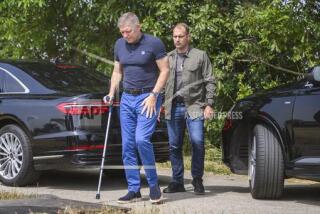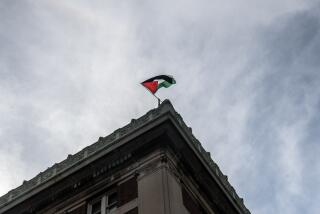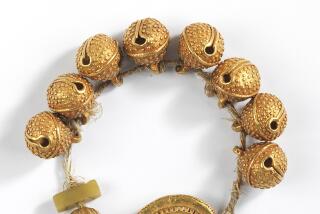Changing Life Styles : Of Holograms and Hounds: Storing the Relics of Repression : Curators at Prague’s Police Museum have taken the symbols of Communist zealotry off display. The change says much about the new face of Eastern Europe.
- Share via
PRAGUE, Czechoslovakia — Brek, the stuffed wonder dog of the Czechoslovak border guards, honored in the not-too-recent past for dragging 60 fleeing citizens back to the cheerless bosom of their Communist homeland, has been hauled off, along with his glass display case, to a basement storeroom, his days of glory done.
Also missing from its special place of honor is the bilious green hologram of Feliks Dzerzhinsky, communism’s first secret policeman, the zealous Polish Bolshevik who in 1917 founded the Cheka, grandfather of the Soviet KGB, and a folk hero to legions of Stalinist enforcers who followed his path.
These are just a few of the extensive alterations speedily under way at the Police Museum in Prague, formerly an institution devoted to the unspoken but implicit proposition that the ever-vigilant Czechoslovak police were dedicated mainly to watching their own people.
The Dzerzhinsky hologram was a nicely symbolic greeting for most visitors: His unblinking eyes appeared to follow a visitor around the room. Now the little chamber at the entrance of the museum, once dominated by his fearsome gaze, stands empty.
And the other day, a brisk squad of workmen was laboring to remove an intimidating array of three dozen rifles, bayonets fixed, that pointed down darkly from the walls, aimed directly at the eyeballs of visitors passing along the main entry hall of the museum.
The rifles and bayonets, the stuffed guard dog, the watchful visage of Dzerzhinsky, were, like the Police Museum itself, unsubtle reminders of the implacable power of the Communist state and its ubiquitous agents of obedience.
The Czechoslovak internal security forces were among the toughest in Eastern Europe, and it was in keeping with their pride that only they would consider creating an entire museum--taking over a monastery, its oldest walls dating from 1350--for the dual purpose of honoring their blunt efficiency and instructing busloads of schoolchildren and other citizens on the totality of the state’s authority.
Now, however, the quickened activity of Dr. Col. Jaroslav Tesar, curator of the museum, is a wonder to behold. A new “revolution” has taken place in Eastern Europe and Czechoslovakia, one hardly imaginable to the designers of displays that once devoted walls of space to the Communist “show trials” of the 1950s, or an array of Bibles and missals described for visitors as “subversive material smuggled by the Vatican.”
Col. Tesar, having gotten rid of Brek, Dzerzhinsky, the once-offending Bibles and numerous other items, is moving as fast as he can to make the Police Museum tread the fine line between the innocuous and the useful.
He has already mounted a display honoring traffic police officers--they smile genially from enlarged photos, wearing their reflective white safety sleeves--and something he calls “drivers’ licenses through the ages.”
He has just begun another display showing “the evolution of police uniforms.” And he has in mind one of those video games he calls “a computerized driving test.”
This new fascination with the police role in auto safety is a manifestation of a concern not just in Czechoslovakia, but throughout post-Communist Eastern Europe, to depoliticize the police. In Poland, where the fearsome riot squads, the Zomo, have been disbanded, the ordinary uniformed law-enforcement officers are now called “police,” not the more martial-sounding “militia” of the Communist days.
Polish authorities also recently fired 1,000 officers from the Warsaw and Krakow police departments, apparently for their less-than-honorable activities under the old Communist regime.
Interior Minister Gen. Czeslaw Kiszczak, a holdover from the Communists, was fired and replaced not long after word began circulating in the Polish Parliament and other knowledgeable circles that “his signature was all over documents” dealing with the harassment and surveillance of political opponents and dissident priests.
The dismissal was instructive. In keeping with the policies that have taken hold in Poland and Czechoslovakia to avoid witch hunts and retribution, Kiszczak went with no public fuss and no public disclosures.
In Czechoslovakia, despite controversies over disclosures that prominent figures may have served as informers, the authorities have accepted President Vaclav Havel’s assertion that all Czechoslovaks share some complicity for totalitarianism because they “accepted it for so long.” Now officially disbanded, the notorious STB security police--the Czechoslovak equivalent of the KGB--has tried to fade out of sight and memory.
Tesar is trying to help the process with his poignant effort to exorcise memory from an institution designed to preserve it. But the pressure is on: At least half a dozen groups would like to get their hands on the museum, including its former deed-holders, the Roman Catholic Church. Others have suggested turning it into a hospital for AIDS patients.
Tesar, 54, dark-haired and athletic-looking, is a former army officer with a degree in “the theory of culture.” He joined the police after mustering out of the army in 1980, with the express goal of managing the Police Museum.
“From 1980, I wanted to change the museum, but it was difficult,” he said. “On the outside, we were a museum, like any other museum, but on the inside we were a police institution, with a commander. The museum opened in 1975 and was to document the security policy of the Communist Party, which was the leading force in society and the most powerful organ of the state. There always had to be ideology. No one, not even the minister of the interior, could do anything without having it approved by the party.”
Tesar, speaking in his spacious office as angel fish glided serenely in a six-foot aquarium, was by turns apologetic and defiant. He acknowledged that virtually everyone in Czechoslovakia once feared the state security.
“On the other hand, I cannot accept collective guilt, because what we have now that we didn’t have then is a growth of criminality so great that no one can do anything about it.
“We go from one extreme to the other. We don’t shut down the theaters because they performed Communist plays by Communist playwrights. Why should we close down this building because it was run by police? Why should we be closed down to make a hospital for AIDS patients?”
When various proposals for the museum were presented to the Interior Ministry, the government department controlling the police, Tesar came up with his own plan.
“Forty years cannot be thrown into drawers,” he said. “It just creates more ‘blank spots,’ ” as gaps in official Communist histories are often called. Included in the plan, he said, “was my suggestion to open up a shooting gallery, open to the public, which would enable us to make up to 40% of our budget.”
With that, he set off on a tour to show his plans for the museum. In a room that once depicted alleged (and futile) Western espionage attempts against the Communists would be the room devoted to “everything that concerns traffic police. We want to have a camera that shows the traffic conditions at, say, the Parliament building. We have everything ready. All the materials. But what can we do if the minister does not support us?”
It is especially helpful to have the curator along on a tour of the museum now--it’s officially closed for the refurbishing--since he can help explain the displays that are no longer there. For example, there are (or were) the 444 handguns confiscated from “agents and subversives” nabbed by the secret police.
“It’s difficult to say that it was exactly 444 they confiscated,” Tesar said, “but it made a nice display.” After a moment of reflection, he added, “It’s also difficult to tell if they were confiscated from people entering the country or leaving.”
Indeed, much of the “history” in the Police Museum was faked, or at least a distortion of the real situation in Czechoslovakia. Tesar is not so much concerned with correcting those distortions--which someday may be, in themselves, of historical interest--as he is in obliterating the evidence that they ever occurred.
Museum records show that 1.1 million persons have visited the museum. It is not included on tourist guides, so it is reasonable to assume that most of the visitors were Czechoslovaks. Apart from the forced marches of schoolchildren through its galleries, it is likely that some visitors got a sardonic laugh from the displays, including the section where Brek stood watch and where the typed explanations spoke of the frontier guards preventing “border violations,” as though they were stopping people from entering Czechoslovakia. They were, of course, preventing people from leaving.
It is also likely that some visitors saw the whole museum as a testament to the people’s determination to escape communism.
In the garden behind the museum, for example, is a homemade tank, made of welded steel plate and painted with a merry parody of camouflage spots, used in one failed emigration attempt.
And in Brek’s former gallery, one display remains of another homemade contraption--part go-cart, part plane, part helicopter--that some desperate Czechoslovak constructed in 1977, with a lawn mower engine and a stolen plastic seat from a public tram bolted to its frame. The thing actually took off and carried its ingenious pilot some distance. Not far enough, unfortunately for him. He cleared the first border fence, but, thinking he had made it, landed in “no-man’s land” before the final barrier, and so was jailed.
“Some guy called us a while back and said he was the man who made it and wanted it back,” Tesar said. “We checked, though, and it was a hoax. I think the man who made it has already left the country.”
More to Read
Sign up for Essential California
The most important California stories and recommendations in your inbox every morning.
You may occasionally receive promotional content from the Los Angeles Times.













